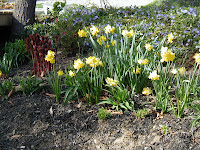





During the day 83 people attended. It was one of the rare days this summer when it didn't rain, and my helpers and I had a chance to visit with some wonderful people as we shared our love of gardens. I had a handout for the attendees which said:
The Casual Garden
This is a wild and wooly garden with a mix of plants (mostly perennial). Some have been gifts, some have been purchased and some just appeared-the hand of nature. Like any family, some are very well behaved and some are a bit of a problem, but each is loved. Well, occasionally I decide something is more trouble than it is worth and out it goes, but generally I find it hard to toss them out. When I divide them I either find a place for the extras or I give them away. Friendship gardens are the result of giving and receiving plants from others. Some of my plants have come from my mother, my grandmother, my Aunt Pink and numerous friends, wonderful memories that I am delighted to share with you.
I enjoyed the day and I hope the visitors did also.








